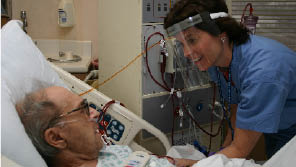Dialysis Nurses Give Patients Special Treatment

Laura Judge Dwyer, BSN, RN, cares for intensive care unit patient Anthony Fiore while he is on dialysis.
Melissa Nichols, of Jackson, Tenn., never expected to receive the comprehensive kind of care she found in the BWH Dialysis Unit. She has been treated in various centers, but the BWH nurses who administered her plasmapheresis and dialysis in the weeks leading up to her kidney transplant made a lasting impression with their kindness, skill and attention to detail.
“They know my little boy’s name, they know all about Tennessee, and if I’m hurting, they immediately respond to see what can be done,” said Nichols, whose nurses are tuned in to her physical and emotional needs.
Each of the 3,000 patients who are treated in the Dialysis Unit each year find the compassion and skillful care that Nichols raved about. “The entire nursing staff consistently demonstrates unparalleled talent, dedication and compassion towards a very vulnerable patient population,” said Nancy Hickey, MS, RN, director of Emergency and Medical Nursing.
“Our dialysis nurses have solid clinical experience and excellent skills,” Joy Taylor, RN, nurse in charge, said of the unit’s nine full-time and two per diem nurses. “They get to know the patients very well and will do anything to cheer them up, like bringing them clothes, toys, books and other gifts.”
Ajay Singh, MD, clinical chief of BWH’s Renal Division and medical director of the Dialysis Unit, said, “Our nurses in the Dialysis Unit are the most compassionate and caring people I know. I have only admiration for their rich experience, their attention and their professionalism.”
Tradition of Excellence
It’s no wonder BWH dialysis nurses are the best. They have a long history of caring for patients like Nicholas. This unit was home to the nation’s very first dialysis machine. Now, under the leadership of Singh, Hickey, and nurses in-charge Taylor and Katherine Serge, MPA, RN, the unit maintains its rich tradition of skillful care coupled with personal attention to ease the suffering of patients with chronic disease.
Because dialysis patients frequently are in the hospital dealing with other medical problems, the unit sees the same patients often. “You get so close to them—it’s like family,” Patricia Sullivan, BSN, RN, said. “There’s true continuity of care because we’ve cared for some of these patients for up to 35 years.”
Most of the dialysis patients are inpatients receiving treatment at the hospital for other medical problems and who usually receive dialysis at outpatient centers. New patients come from the renal clinic and are started on dialysis before they proceed to outpatient centers for regular treatments. These patients depend on the teaching and emotional support of nurses as they come to grips with the fact that they will need dialysis for the rest of their lives.
Teamwork is Key
The dialysis nurses work together to staff the six bed unit with all the characteristics of a highly skilled team. This teamwork is what defines the unit. “The population that needs dialysis has grown in leaps and bounds over the last few years,” Serge said. “Our staff work closely together because we can’t go into diversion when we have too many patients. We just keep going as long as we need.”

From left, social worker Amy Lucid-Inezian, NIC Joy Taylor, RN, administrative secretary Gail Appling, nurses Kevin Calderone, BSN, RN, and Kim Bold, RN, and Renal Fellow Eugene Rhee, MD, all are critical members of the dialysis team.
Like clockwork, nurses team up to take a patient off the dialysis machine, clean the machine and prepare it for the next patient. The support of housekeeper Aretha Shine and patient care assistant Debbie Sargeant is crucial to turning beds over quickly. Sargeant also is well-versed in JCAHO regulations and plays a vital role in ensuring the unit is compliant. Administrative secretary Gail Appling ensures smooth patient flow through the busy unit. As needed, nurses travel to the intensive care units to dialyze patients who cannot come to the center.
Laura Judge Dwyer, BSN, RN, has been in the unit for 24 years and cites the teamwork and compatibility of the nurses as key to their longevity in the unit. “When one patient gets sick while on dialysis, we’re all there working together to help the patient,” she said.
Empowering Patients
“Our nurses are extremely friendly, outgoing and positive, and they really advocate for the patients,” Serge said.
That’s important, as patients are rendered helpless for the three to four hour-treatments three times a week. The advocacy doesn’t stop when patients leave BWH to resume or begin treatment at an outpatient dialysis center.
“Our number one goal is to teach our patients how to take care of themselves,” Judge said. “When they leave us to go to an outpatient dialysis center, we make sure they have the knowledge to follow their own care and know how the machine works. That way, they’re comfortable receiving treatment at any center.”
This commitment to helping patients cope with chronic disease and improve their quality of life impresses patients and their families.
Asked what makes BWH nurses the best, Nichols’ mother Sandra Arnold summed it up: “Because they care.”

Dialysis nurse Kim Bold, RN, cares for patient Mack Smith as he finishes his dialysis treatment.